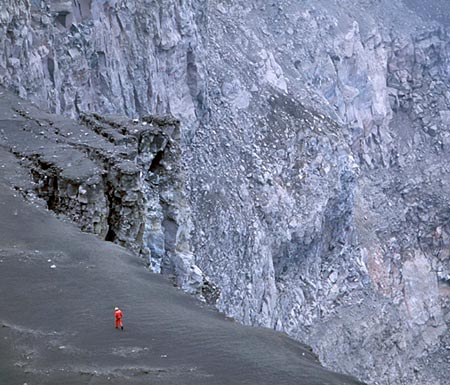|

by Zecharia Sitchin
November 2001
from
Sitchin Website
At the end of the third millennium B.C.
the great Sumerian civilization came to an abrupt end. Its sudden
demise was bewailed in numerous
lamentation texts that have been
discovered by archeologists. The texts ascribed the calamity to an
Evil Wind that came blowing from the west (from the direction of the
Mediterranean Sea) -- a deathly cloud that caused excruciating death
to all living beings, people and animals alike, that withered plants
and poisoned the waters.
In
The Wars of Gods and Men, Zecharia Sitchin saw an explanation of
the sudden death in a long text known to scholars as
The Erra Epos,
that described a chain of events that ultimately led to the use of
“Weapons of Terror” in a conflict between opposing clans of the
Anunnaki ("Those who from Heaven to Earth came").
Based on the descriptions of the weapons in the Erra Epos, and in
the lamentation texts, Zecharia Sitchin concluded that the Weapons
of Terror were nuclear weapons. Used to obliterate the spaceport
that then existed in the Sinai Peninsula (and some “sinning cities”
such as Sodom and Gomorrah), the nuclear cloud then was carried by
the prevailing winds eastward, causing death and desolation in the
Lands Between the Rivers (Mesopotamia) -- the empire of Sumer and
Akkad.
Besides claiming that nuclear weapons were first used on Earth not
in the 1940’s in Hiroshima but thousands of years earlier in the
Near East, Zecharia also pinpointed the date: 2024 B.C.!
Scientific
Corroboration Now Comes Along
That the civilization that sprang out in Sumer circa 3800 B.C. –
reaching unparalleled heights under the last dynasty, the Third
Dynasty of Ur (Abraham’s city) -- had come to an abrupt end near the
end of the third millennium B.C. has been an accepted and well
documented fact. That the end was abrupt, was also certain. What
scholars deemed as still lacking was an explanation: How and what
caused it?
Beginning in 1999, archaeologists and scholars specializing in the
Near East saw mounting evidence that the demise of Sumer and Akkad (Sumer’s
northern extension) coincided with an abrupt climate change. An
initial study by Harvey Weiss and Timothy C. Wieskel of
Harvard
University was reinforced by a subsequent study (Geology, April
2000) by H.M. Cullen et al from the Lamont-Doherty Earth
Observatory of Columbia University, the University of Utah, the
Lawrence Livermore National Laboratory, and the Institute für
Geowissenschaften, Germany.
Based on studies of unexplained aridity
and wind-blown dust storms and radiocarbon datings, they reported
that their readings indicated a date of 4025 years ago (plus or
minus a margin of 125 years).
A precise date
corroborated!
Those and similar climate-change studies, relating the climate
conditions to the rise and fall of civilizations in the Old as well
as the New Worlds, were summed up in a major study published in the
prestigious journal Science in its 27 April 2001 issue. Authored by
Peter B. de Menocal of the Lamont-Doherty Earth Observatory
of Columbia University, the study paid particular attention to
sedimentary remains of
Tephra; the telltale rock fragments confirmed
the date 4025 Years Before Present.
And 4025 years, before the present year A.D. 2001 -- is exactly 2024
B.C., as Zecharia Sitchin had determined in his 1985 book!
The Tephra
Mystery
The reliance of this latest study on the Tephra evidence is doubly
significant.
While the previous studies spoke of “wind blown dust,” this latest
study focuses on a material called Tephra. And what is Tephra? It is
defined in geology textbooks thus:
When a volcano erupts, it will sometimes eject material such as rock
fragments into the atmosphere. This material is known as Tephra.

Tephra
Tephra is a
general term for fragments of volcanic rock and lava that are
blasted into the air by explosions or carried upward by hot gases.
Tephra includes
large, dense chunks, light rock debris, and ash.
These burnt-through pieces of blackened gravel-like rock mostly fall
near their volcanic source; but ash-like particles can be carried by
prevailing winds over many miles and can stay aloft for more than a
year.
The area in the Sinai Peninsula where the destroyed spaceport had
been is indeed covered -- to this day! -- with grave-like
burnt-through blackened stones (for photo evidence
see illustrations
105, 106, & 107 in The Wars of Gods and Men). But as Zecharia has
pointed out in his book; there are NO VOLCANOES in the Sinai
Peninsula. In the Sinai Peninsula, the source of the wind-carried
dust remains a mystery.
And the only explanation for these broken and blackened stones in
the Sinai (click below image) and the windblown desolation in Mesopotamia can be
the
tale of the Erra Epos, (reflected in the biblical tale of the
upheaval of Sodom and Gomorrah):

not an eruption by a non-existent
volcano, but the use of nuclear weapons in 2024 B.C.
|


